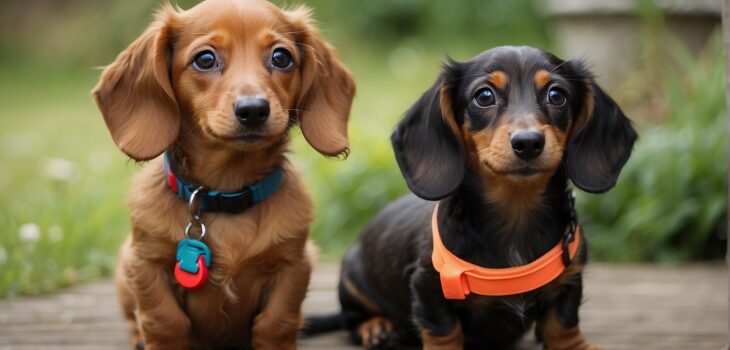So, you’ve recently welcomed a cute and cuddly Dachshund into your home, and now you’re facing the challenges of potty training. Dachshunds, with their adorable long bodies and spunky personalities, can be a bit stubborn when it comes to mastering this important skill. But fear not, because in this article, you will discover some invaluable tips that will make the potty training process a breeze for you and your furry friend. Stick around, and soon you’ll be saying goodbye to accidents and hello to a well-trained Dachshund!
Understanding Dachshunds and Potty Training
Dachshunds, also known as wiener dogs, are a charming and affectionate breed. However, when it comes to potty training, they can pose a unique set of challenges. Understanding the breed characteristics and factors that affect potty training is crucial in successfully housebreaking your dachshund. Additionally, consistency and patience are key to establishing good potty habits. In this article, we will explore various aspects of potty training dachshunds and provide helpful tips to make the process smoother for both you and your furry companion.
Dachshund Breed Characteristics
Dachshunds are small dogs with a long body and short legs. This distinctive physique is partly responsible for the difficulties they may encounter during potty training. Their long spine makes it challenging for them to control their bladder and bowel movements, especially at a young age. Furthermore, dachshunds are known to be stubborn, independent, and sometimes willful. These traits can make them resistant to training and require extra effort on your part to establish consistent potty habits.
Factors That Affect Potty Training
Several factors can influence the success of potty training your dachshund. Firstly, their age plays a significant role. Younger dachshund puppies have smaller bladders and a limited ability to hold their urine for extended periods. Therefore, they will require more frequent trips to the designated potty area. Additionally, it is essential to consider your dachshund’s overall health. Certain medical conditions, such as urinary tract infections, can affect their ability to control their bladder or cause frequent accidents. Consulting with a veterinarian is advisable if you suspect any underlying health issues impacting your dachshund’s potty training progress.

Importance of Consistency and Patience
Consistency and patience are fundamental when it comes to potty training any dog, and dachshunds are no exception. Establishing a routine and sticking to it will help your dachshund understand the expectations and develop good potty habits. Set specific times for feeding, watering, and potty breaks, and follow them consistently. Remember that accidents are a natural part of the training process, so it is essential to remain patient and avoid punishment. Harsh discipline can lead to fear or anxiety, hindering progress rather than promoting it.
Preparing for Potty Training
Before diving into potty training, it is crucial to make the necessary preparations. The following steps will help set the stage for successful housebreaking:
Establishing a Designated Potty Area
Designating a specific area in your yard for your dachshund’s potty needs is crucial. Consistency is key here as well. Always take your dachshund to the same spot to eliminate any confusion. The scent of their previous eliminations will also act as a cue, reminding them of the purpose of that area. Make sure the designated potty area is easily accessible and safe for your dachshund to navigate.
Choosing the Right Potty Training Supplies
Having the appropriate potty training supplies is essential for a smoother experience. Invest in a sturdy leash, a collar or harness, and poop bags for cleaning up after your dachshund. Additionally, consider using a long leash or a retractable leash to give your dachshund some freedom within the designated potty area without the risk of them wandering off.

Setting a Regular Potty Schedule
Establishing a regular potty schedule is crucial for developing consistency in your dachshund’s potty habits. Determine the appropriate frequency of potty breaks based on your dachshund’s age and individual needs, and ensure that you stick to the schedule as closely as possible. Consistent timing will help your dachshund anticipate when it’s time to go and avoid accidents indoors.
Positive Reinforcement Techniques
Positive reinforcement is a powerful tool when it comes to training your dachshund. Incorporating praise, treats, and clicker training into your potty training routine can motivate your dachshund to adopt desirable behaviors.
Using Verbal Praise
Dachshunds respond well to verbal praise and encouragement. When your dachshund successfully eliminates in the designated potty area, immediately offer enthusiastic verbal praise. Use a happy and upbeat tone of voice, and make sure to shower them with lots of attention and affection.
Rewarding with Treats
Treats are a delicious incentive that can reinforce good potty habits. Keep a stash of small, bite-sized treats near the designated potty area, and offer one as soon as your dachshund finishes eliminating. Make sure to choose high-value treats that your dachshund finds particularly enticing to maximize their motivation.
Implementing Clicker Training
Clicker training is a popular positive reinforcement technique that can enhance communication between you and your dachshund. Start by associating the sound of the clicker with a reward, such as a treat. Once your dachshund makes the connection between the click sound and the treat, you can use the clicker to mark and reinforce desired behavior during potty training. Click immediately when your dachshund eliminates in the right spot, and follow it with a treat and praise.
Effective Training Methods
Different training methods can be employed to make potty training more effective for your dachshund. Consider the following techniques to find the approach that works best for both you and your furry friend.
Crate Training
Crate training is a widely used method for potty training dogs, including dachshunds. Dogs naturally avoid soiling their immediate living space, making a crate an effective tool for preventing accidents indoors. When implemented correctly, a crate becomes a safe and comfortable den for your dachshund, where they can rest and relax. Gradually introduce your dachshund to the crate and ensure it is the appropriate size for them to stand, turn around, and lie down comfortably. Use positive reinforcement techniques to associate the crate with positive experiences, and never use it for punishment.
Using Training Pads or Litter Boxes
Training pads or litter boxes can be helpful for dachshunds, especially during the early stages of potty training. These designated indoor spots provide a convenient alternative to outdoor potty breaks. Place the training pad or litter box in a consistent location within your home and gradually move it closer to the designated outdoor potty area over time. Use positive reinforcement to encourage your dachshund to use the designated spot indoors and gradually transition them to outdoor elimination.
Teaching the ‘Go Potty’ Command
Teaching your dachshund a command associated with going potty can enhance communication and streamline the training process. Choose a simple and consistent phrase, such as “go potty” or “do your business,” and use it every time you take your dachshund to the designated potty area. Repetition is key here. Say the command phrase in an encouraging tone as soon as your dachshund starts eliminating, and reinforce the behavior with praise and treats. Eventually, your dachshund will associate the command with the desired action.
Addressing Accidents and Mistakes
Accidents are an inevitable part of the potty training journey, especially during the initial stages. It’s essential to handle accidents and mistakes appropriately to prevent setbacks and maintain a positive learning environment for your dachshund.
Avoiding Punishment
Punishing your dachshund for accidents is counterproductive and can hinder the potty training process. Shouting, scolding, or physically punishing your dachshund will only create fear and anxiety, making them less likely to associate elimination with the designated potty area. Instead, focus on reinforcing positive behavior and redirecting your dachshund to the appropriate spot whenever accidents occur.
Immediate Action for Indoor Accidents
In the event of an indoor accident, it’s crucial to respond promptly. Interrupt your dachshund if caught in the act of eliminating indoors by clapping your hands or making a loud noise to startle them (without scaring them). Immediately bring your dachshund to the designated potty area and allow them to finish eliminating there. Clean up the accident using an appropriate pet-friendly cleaner and dispose of any odor-causing substances. Remember, it’s essential to remove any lingering odors to prevent your dachshund from associating that area with a potty spot.
Cleaning and Neutralizing Odors
Proper cleaning and odor neutralization are crucial to prevent your dachshund from repeatedly eliminating in the same spot. Regular household cleaners may not eliminate the odor entirely, causing your dachshund to consider that spot as an appropriate potty area. Invest in enzymatic cleaners specifically designed to neutralize pet odors. Follow the manufacturer’s instructions to effectively remove any lingering scents and discourage your dachshund from reoffending.
Dealing with Challenges and Setbacks
Potty training can present various challenges and setbacks for both you and your dachshund. Understanding and addressing these issues promptly will help maintain progress and ensure a successful training outcome.
Handling Separation Anxiety
Dachshunds are known for their strong attachment to their owners, which can lead to separation anxiety when left alone. Separation anxiety can manifest in unusual potty behavior, such as increased accidents or refusal to eliminate outdoors without their owner. To tackle this issue, gradually acclimate your dachshund to being alone and develop a routine that includes plenty of exercise and mental stimulation. Additionally, provide comforting items, such as a favorite toy or an article of clothing with your scent, to help alleviate their anxiety.
Managing Marking Behavior
Marking behavior, where a dog urinates in small amounts to leave their scent, can be a concern during potty training. Male dachshunds, in particular, are prone to marking their territory. To manage this behavior, make sure your dachshund is neutered or spayed, as this can reduce marking tendencies. Consistent positive reinforcement and closely supervising your dachshund indoors until they establish good potty habits will also help discourage marking.
Recognizing Regression and Adjusting Strategies
Regression is not uncommon in potty training. Your dachshund may have accidents or exhibit behavior reminiscent of their earlier training stages. This can occur due to various factors, such as changes in the household routine, stress, or illness. If you notice regression, it’s crucial not to get discouraged. Revisit the basics of potty training, reinforce positive behaviors, and reestablish consistency. Patience and persistence are key when adjusting your strategies to accommodate your dachshund’s needs.
Socialization and Potty Training
Proper socialization is vital for a well-rounded dachshund and can also impact their potty training progress. By exposing your dachshund to different environments, you will help them become comfortable eliminating in various locations and settings.
Exposing Dachshunds to Different Environments
Take your dachshund on regular outings to introduce them to different environments and surfaces. Expose them to parks, sidewalks, and other areas where they can comfortably eliminate. This exposure will help them generalize their potty training skills and reduce the likelihood of accidents when they are outside their usual setting.
Encouraging Proper Bathroom Etiquette
Teaching your dachshund proper bathroom etiquette is essential, especially when visiting other people’s homes or public spaces. Always carry bags to clean up after your dachshund when outside. Encourage your dachshund to eliminate in appropriate areas, and reward them for doing so. By consistently reinforcing proper bathroom etiquette, you can ensure your dachshund remains well-behaved and respectful in various settings.
Understanding the Role of Other Pets
If you have other pets in your household, their behavior and routines can impact your dachshund’s potty training process. Particularly in multi-dog households, competition for resources like potty areas can arise. Monitor interactions between your dachshund and other pets during potty breaks and ensure each pet has their designated area or a sufficient partition. Address any potential conflicts or resource guarding behavior promptly to maintain a peaceful and conducive environment for potty training.
Seeking Professional Help
Sometimes, potty training can be challenging, and seeking professional help is a wise decision. Veterinarians and dog trainers are valuable resources that can provide guidance and support throughout the training process.
Consulting with a Veterinarian or Dog Trainer
If you are struggling with potty training despite your best efforts, consulting with a veterinarian or a professional dog trainer is highly recommended. They can assess your dachshund’s individual needs, identify any underlying health issues, and provide personalized guidance tailored to your specific situation. Professional advice can go a long way in making the potty training process more effective and successful.
Considering Puppy Training Classes
Puppy training classes offer a structured environment for both you and your dachshund to learn together. These classes provide valuable socialization opportunities, guidance from experienced trainers, and a chance to observe and learn from other dog owners. Look for classes specifically designed for small breed dogs or those that address potty training challenges, as they will be more tailored to your dachshund’s needs.
Finding Support from Online Communities
Online communities and forums dedicated to dachshund owners can provide a wealth of information and support. Connecting with other dachshund owners who have gone through or are currently going through potty training can offer valuable insights, tips, and encouragement. Share your experiences, ask questions, and participate actively in these communities to gain a sense of camaraderie and mutual support.
Additional Tips and Advice
In addition to the main aspects of potty training, these additional tips can contribute to a smoother training journey and reinforce good habits:
Monitoring Water Intake
Observe your dachshund’s water intake and adjust it accordingly. Limiting water access during specific times, especially before bedtime, can help minimize accidents during the night. Remember, dehydration can be detrimental to your dachshund’s health, so always ensure they have access to fresh water throughout the day.
Keeping a Potty Training Journal
Keeping a potty training journal can be beneficial in tracking your dachshund’s progress, identifying patterns, and noting any challenges or setbacks. Documenting the times your dachshund eliminates, the frequency of accidents, and any potential triggers or changes in behavior can help you make informed decisions and adjust your training strategies accordingly.
Celebrating Milestones
Celebrate your dachshund’s potty training milestones to reinforce positive associations with the process. Whether it’s a small treat, extra playtime, or a belly rub, these rewards will help your dachshund feel accomplished and motivated to keep up the good work. Celebrating milestones will also remind you of the progress you and your dachshund have made together.
Conclusion
Potty training a dachshund may require extra effort and patience, but the bond and understanding you establish through the process are invaluable. By understanding the breed characteristics, preparing appropriately, implementing positive reinforcement techniques, and addressing challenges promptly, you can successfully potty train your dachshund. Remember to maintain consistency, be patient with accidents, and seek professional help when needed. The effort you invest in potty training will not only create a well-behaved dachshund but also enhance the overall training experience and strengthen the bond between you and your furry companion. With consistent positive reinforcement, you will set your dachshund up for success not only in potty training but also in other aspects of their training journey.




